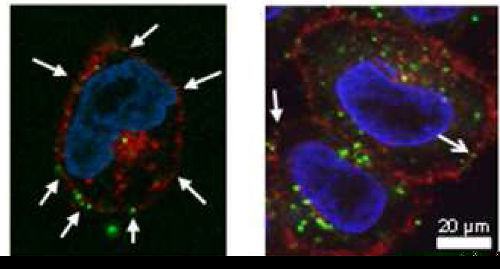A team of American and Chinese researchers has shown that disk-shaped nanoparticles do not cross the cell membrane but remain attached to the membrane.
 Fluorescence microscopy images show HeLa cells incubated for two hours with disk-shaped nanoparticles (left) and with spherical nanoparticles (right). The nanodisks (green dots indicated with white arrows) remain confined to the cell membrane while nanospheres (green dots) permeate the cell. (credit: ACS Appl. Mater. Interfaces)
Fluorescence microscopy images show HeLa cells incubated for two hours with disk-shaped nanoparticles (left) and with spherical nanoparticles (right). The nanodisks (green dots indicated with white arrows) remain confined to the cell membrane while nanospheres (green dots) permeate the cell. (credit: ACS Appl. Mater. Interfaces)
According to the team, this finding may be helpful in designing fluorescent nanoparticle tags to track cells without affecting them. Scientists had already discovered that the interaction between nanoparticles and cells get affected by the size of the particles.
A nanoparticle must have a specific size, which is neither too large nor too small, to pass through the cell membrane. A modeling study also suggested that the cell membrane does not allow flat nanoparticles to pass through, but allows nanospheres.
To experimentally confirm the proposal of the model, Bing Yan of Shandong University and his collaborators compared the interaction of cells with disk-shaped and spherical nanoparticles that have the same diameter of 20 nm. They synthesized nanodisks through the polymerization of butylstyrene, divinylbenzene and styrene, and purchased commercial nanospheres. They then added either nanospheres or nanodisks to human cells such as HeLa cells and analyzed using fluorescence laser microscopy and transmission electron microscopy. What they discovered was the nanospheres entered into the cell interior by passing through the cell membrane, while the nanodisks remain largely detained at the membrane.
The researchers believe that geometry is the reason behind the difference in behavior of the nanoparticles. A nanodisk binds to the cell membrane by making contact over a broader area with it. On the other hand, a spherical particle induces endocytosis by merely indenting the membrane, making the membrane to engulf them, stated Yan. Since disk-shaped nanoparticles do not enter into the cell, they can be used to track stem cells.
The scientists also discovered that contrary to nanospheres, nanodisks did not harm or even upset the cell cycle. The nanodisks may also help perform the cell membrane study if they carry labels that bind to membrane receptors.
Source: http://cen.acs.org